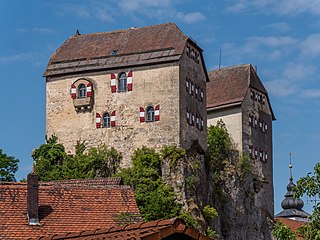

The Sparneck family was an old German noble family from Franconia.


The Sparneck family was an old German noble family from Franconia.
The family is known to exist from 1223 to 1744 and was named after the market village of Sparneck. One of their first castles was the Waldsteinburg; further castles were located in Sparneck, Weißdorf, Stockenroth, Uprode near Weißdorf, Stein near Gefrees, Hallerstein (now part of Schwarzenbach an der Saale) and Gattendorf. Their homeland corresponds to the old district of Münchberg, now part of the district of Hof. The family is directly related to the Houses of Bibra, Gravenreuth, Guttenberg, Kotzau, Künsberg, Notthafft, Pappenheim, Reitzenstein and Zedtwitz. As a consequence of supporting the robber baron Thomas von Absberg, they were forced to give up their origin lands and moved to Upper Palatinate, keeping only few fiefs, the so-called Afterlehen , e.g. in Bernstein near Wunsiedel and Dörflas, now a part of Marktredwitz. For two generations they can be found in Libá. At last they owned manor houses in Trausnitz, Püchersreuth and Reuth bei Erbendorf.

Bovenden is a municipality in the district of Göttingen, in Lower Saxony, Germany. In 2020 the population in the eight villages belonging to the municipality was 13,891.
Gustav Reinhold Röhricht was a German historian of the Crusades.
Andreas von Graben zu Sommeregg was a Carinthian knight and nobleman residing at Sommeregg Castle. He served as a burgrave and castellan governor in the Ortenburg estates, held by the Counts of Celje until 1456. With the extinction of the Cillier family, Von Graben lost the post of captain of the County of Ortenburg under the Habsburgs, their successors as Ortenburg sovereign.

The Waldsteinburg, also called the Red Castle is a ruined castle on the summit of the Großer Waldstein in the Fichtel Mountains of Germany. It is also known as the Westburg to distinguish it from the older ruins of the Ostburg.

The Ehrenbürg is a double-peaked butte on the edge of the Franconian Jura in Bavaria, Germany. It is in the district of Forchheim in Upper Franconia, in the municipalities of Kirchehrenbach, Leutenbach and Wiesenthau. The north peak is the 513.9 m Walberla, the south peak the 531.7 m Rodenstein. The hill is popularly known as the Walberla.
Frederick II von Graben, also called Frederick the Younger, was a Styrian noble, a member of the edelfrei Von Graben family. He held the titles as Lord of Kornberg and Marburg, the Lordship Marburg as well as burgrave of Riegersburg. One of the most affluent Styrian nobles, Frederick was an advisor to the Habsburg emperor Frederick III, where he held a special position, assessor at the Reichskammergericht, and member of the duchy's Landtag assembly.
Hans Thomas von Absberg was a Frankish knight of the Absberg family, known as a robber baron.

The House of Kotzau was an old minor German noble family in Franconia, Germany.

The Gravenreuth family was an old German noble family, originally from Franconia, whose members held significant positions in Prussia and later in the German Empire.

Wolfgang von Graben, also Wolfgang de Groben and Wolfgang Grabenski was born in Kornberg castle, Styria and a member of the Austrian nobility. He held the titles as a Lord of Graben, Kornberg, the Lordship Marburg with Obermarburg and Maribor Castle, Radkersburg, Neudenstein, Weinberg and Burggrave (Viscount) of Saldenhofen.
The Bavarian War from 1459 to 1463, also known as the Princes' War, was a result of the expansionist ambitions of the two warring Principalities, pitting Margrave, later Elector, Albert Achilles from the House of Hohenzollern, which by this time had already annexed the principalities of Brandenburg-Kulmbach and Brandenburg-Ansbach, against Duke Louis "the Rich" of Bavaria-Landshut from the House of Wittelsbach.

The Liebenau monastery was a Dominican monastery. It was located outside the city gates of Worms in today's Worms-Hochheim district.

Baron Henri Eduard Joseph de Lannoy, was a Flemish composer, teacher, conductor, and writer on music who spent most of his life in Austria. His compositions bridge the classical and early romantic styles. His full name and title in German was 'Heinrich Eduard Josef, Freiherr von Lannoy'.

The Franconian War was waged in 1523 when the Swabian League attacked several robber baron castles in Franconia, whose nobles were supporters of Hans Thomas of Absberg in the Absberg Feud.

Hiltpoltstein Castle was originally a high mediaeval aristocratic castle dating to the 11th or 12th century. It stands in the centre of the market village of Markt Hiltpoltstein in the Upper Franconian county of Forchheim in the south German state of Bavaria. Its present appearance as a triple-winged building goes back to renovations carried out at the end of the 16th century.
Peter Herde is a German historian. His research activities range from fundamental work on papal diplomatics of the Middle Ages to the history of the country up to the Second World War.

Harry Weibel is a German historian. His main topics are neo-Nazism, right-wing extremism and antisemitism in the GDR and racism in Germany from 1945 to the present.

The Lordship of Franckenstein was a historical territory in the northern Odenwald. It originated around 1230 from the possessions of the Breuberg, whose center was Frankenstein Castle. Konrad II of Breuberg and his wife Elisabeth of Weiterstadt called themselves Frankenstein after having build the castle henceforth. The dominion remained as condominium in the possession of the family until the year 1662. After the sale by the Frankensteis to Landgrave Louis VI, Landgrave of Hesse-Darmstadt, it came into the possession of Hesse-Darmstadt.

Count Christian of Nassau-Siegen, German: Christian Graf von Nassau-Siegen, official titles: Graf zu Nassau, Katzenelnbogen, Vianden und Diez, Herr zu Beilstein, was a count from the House of Nassau-Siegen, a cadet branch of the Ottonian Line of the House of Nassau. He served as an officer in the Hessian Army and the Imperial Army successively.

Himmelkron Abbey is located in Himmelkron in the district of Kulmbach in Upper Franconia, Bavaria, Germany. From the 13th to the 16th century it was a Cistercian abbey in the Archdiocese of Bamberg. It then served the Margraviate of Brandenburg-Bayreuth as a summer residence and Jagdschloss until the 19th century. Today it is a residential home and day care center for people with intellectual disabilities.